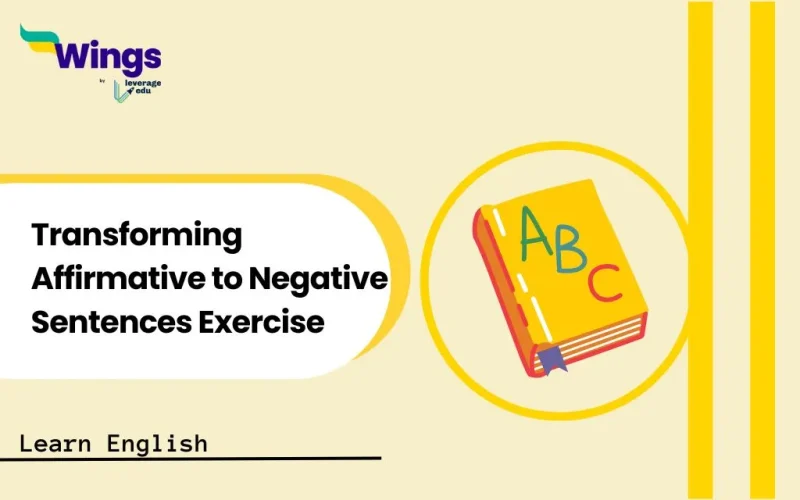Language is a powerful tool, and understanding how to transform sentences correctly can improve both writing and speaking skills. One of the essential grammar exercises that learners often struggle with is changing affirmative sentences into negative ones. If you’re looking for an easy, step-by-step guide with a practical transforming affirmative to negative sentences exercise, this complete blog will help you understand the difference between the two.
This Blog Includes:
What Is an Affirmative and a Negative Sentence?
Before jumping into the transforming affirmative to negative sentences exercise, let’s clarify what affirmative and negative sentences are.
- Affirmative Sentence: A sentence that states something as true.
Example: She likes ice cream.
- Negative Sentence: A sentence that negates or denies something by adding words like “not,” “never,” or “no.”
Example: She does not like ice cream.
Check out Types of Sentences in English with Examples and Exercises
Basic Rules for Converting Affirmative to Negative Sentences
To successfully convert affirmative sentences to negative ones, follow these simple rules. These rules will help you solve questions of transforming affirmative to negative sentences exercise.
1. Use ‘Not’ with Auxiliary Verbs
Most sentences in English use auxiliary verbs like is, are, was, were, have, has, do, does, etc.
To make them negative, simply add not after the auxiliary verb.
- Affirmative: He is playing football.
- Negative: He is not playing football.
2. Add ‘Do Not / Does Not / Did Not’ for Simple Present and Past Tense
For simple present and past tense verbs without auxiliary verbs, use do/does (for present) or did (for past) and add not before the main verb.
- Affirmative: She sings beautifully.
- Negative: She does not sing beautifully.
- Affirmative: He wrote a book.
- Negative: He did not write a book.
3. Use Negative Words like ‘Never,’ ‘No,’ or ‘None’
Sometimes, replacing words with their negative counterparts can help.
- Affirmative: She always arrives early.
- Negative: She never arrives early.
4. Change Words That Imply Positivity
Some words automatically turn sentences affirmative, like “some” or “already.” Replacing them with “any” or “yet” makes them negative.
- Affirmative: I have already finished my homework.
- Negative: I have not finished my homework yet.
Explore Simple English Sentences: 199+ Examples for Daily Use
Transforming Affirmative to Negative Sentences Exercise (With Answers)
Now that you understand the basics, let’s put your skills to the test. Practice questions of transforming affirmative to negative sentences exercise given below.
Exercise 1: Convert These Sentences into Negative Form
- She likes to dance.
- They play football every weekend.
- He has visited Paris.
- We saw a beautiful rainbow.
- I want some coffee.
- He speaks French fluently.
- They have completed their homework.
- She was watching TV.
- We will go to the party.
- He needs some help.
- She loves to paint.
- They have finished their homework.
- He is reading a novel.
- We will travel to London next month.
- I bought a new dress yesterday.
- The sun rises in the east.
- She was cooking dinner when I arrived.
- You should drink more water.
- He can play the guitar well.
- There is some sugar in the jar.
- The students were listening to the teacher.
- He has written a beautiful poem.
- I always go for a walk in the morning.
- They will help us with the project.
- She found her lost keys.
- The baby slept peacefully.
- We have a meeting at 10 a.m.
- You must submit the assignment by Monday.
- She speaks three languages fluently.
- He was watching a movie last night.
Answers:
- She does not like to dance.
- They do not play football every weekend.
- He has not visited Paris.
- We did not see a beautiful rainbow.
- I do not want any coffee.
- He does not speak French fluently.
- They have not completed their homework.
- She was not watching TV.
- We will not go to the party.
- He does not need any help.
- She does not love to paint.
- They have not finished their homework.
- He is not reading a novel.
- We will not travel to London next month.
- I did not buy a new dress yesterday.
- The sun does not rise in the west.
- She was not cooking dinner when I arrived.
- You should not drink more water.
- He cannot play the guitar well.
- There is not any sugar in the jar.
- The students were not listening to the teacher.
- He has not written a beautiful poem.
- I do not always go for a walk in the morning.
- They will not help us with the project.
- She did not find her lost keys.
- The baby did not sleep peacefully.
- We do not have a meeting at 10 a.m.
- You must not submit the assignment by Monday.
- She does not speak three languages fluently.
- He was not watching a movie last night.
Also Read: What are Declarative Sentences?
Why Should You Master Affirmative to Negative Conversions?
- Improves Writing Clarity: Being able to use both affirmative and negative forms helps in better communication.
- Enhances Spoken English: In conversations, expressing disagreement or denial naturally is important.
- Boosts Exam and Grammar Test Scores: Many English proficiency exams include sentence transformations.
FAQs
Affirmative sentences express a positive statement, while negative sentences deny something by using words like not, never, or no.
Use auxiliary verbs like do/does/did or not after the main verb. For example, “He plays football” becomes “He does not play football.”
Understanding this concept helps improve grammar, writing clarity, and communication skills, making English proficiency stronger.
Common errors include forgetting to use the correct auxiliary verb, double negatives, and incorrect word placement.
Yes! Websites like Leverageedu.com, Grammarly, EnglishGrammar.org, and Cambridge English offer free exercises for sentence transformations.
For more information on English grammar and language, follow the Learn English page of Leverage Edu now!!
 One app for all your study abroad needs
One app for all your study abroad needs















 60,000+ students trusted us with their dreams. Take the first step today!
60,000+ students trusted us with their dreams. Take the first step today!

